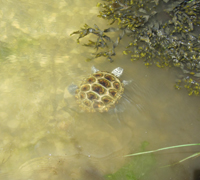 The Wetlands Institute releases baby turtles, cuteness ensues
The Wetlands Institute releases baby turtles, cuteness ensues
by Bernard Brown
Take my word for it: Nothing is cuter than kindergartners with baby turtles. On June 15, a fellow herper (i.e. reptile and amphibian enthusiast) and I drove to Stone Harbor, NJ, to watch the Wetlands Institute release baby diamondback terrapins. The researchers at the Institute could have easily had interns dump the turtles back into the marsh, but these are clever herpetologists—they turned the release into an environmental education event (not to mention a brilliant photo op), inviting local school children to do the liberating.
Grid’s terrapin-savvy readers might wonder about the timing. Babies? Aren’t the female terrapins laying eggs right now? Indeed, the babies that the Wetlands Institute released in June hatched from eggs salvaged from road-killed females in 2009 and “head started” for a year at Stockton College, giving them a leg up on predators. This year’s wild hatchlings should be popping out of their nests from late August into early October. Life is tough for the little tykes—or, as the Wetlands Institute’s Roger Wood called them, “seagull potato chips.”
Life isn’t easy for their moms either. The females crawl out of the brackish marshes from June through July to dig their nests, and evolution has not equipped them to deal with Shore traffic. They make matters worse for themselves with extremely picky nesting habits. The girls will dig several test holes until they settle on just the right sand for laying their eggs (about 10 eggs per clutch). We brought in two freshly run-over females, found on the way to the release event, and saw several more on the way home.
Terrapin populations bounced back after almost being wiped out for the soup trade in the beginning of the 20th century. But, along with crab traps that drown them, the recent Jersey Shore development boom (which equals lots of cars) is again dragging them down.
 We can all help by slowing down and assisting terrapins we find on the road. If you happen upon a mother terrapin trying her chances on the asphalt, make sure to move her across in the direction she was heading; turtles are stubborn and will only start all over if you move them back. The Wetlands Institute’s website features examples of citizen-driven turtle fencing projects (to keep them from crossing in the first place), so if you live or vacation near a particularly turtle-hazardous road, you might be able to make it safer.
We can all help by slowing down and assisting terrapins we find on the road. If you happen upon a mother terrapin trying her chances on the asphalt, make sure to move her across in the direction she was heading; turtles are stubborn and will only start all over if you move them back. The Wetlands Institute’s website features examples of citizen-driven turtle fencing projects (to keep them from crossing in the first place), so if you live or vacation near a particularly turtle-hazardous road, you might be able to make it safer.
Want to learn more about terrapins? The Wetlands Institute is the place to start, either at their exhibits in Stone Harbor (a great break from sunbathing), or on their website, where you can learn more about terrapin biology, and get updates on their innovative terrapin research and conservation projects.

